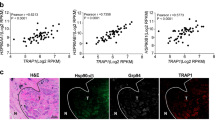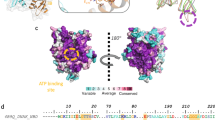Abstract
Heat shock protein 90 (Hsp90) is a molecular chaperone that plays a key role in the conformational maturation of oncogenic signalling proteins, including HER-2/ErbB2, Akt, Raf-1, Bcr-Abl and mutated p531,2,3,4,5,6,7. Hsp90 inhibitors bind to Hsp90, and induce the proteasomal degradation of Hsp90 client proteins6,8,9,10,11. Although Hsp90 is highly expressed in most cells, Hsp90 inhibitors selectively kill cancer cells compared to normal cells, and the Hsp90 inhibitor 17-allylaminogeldanamycin (17-AAG) is currently in phase I clinical trials12,13. However, the molecular basis of the tumour selectivity of Hsp90 inhibitors is unknown. Here we report that Hsp90 derived from tumour cells has a 100-fold higher binding affinity for 17-AAG than does Hsp90 from normal cells. Tumour Hsp90 is present entirely in multi-chaperone complexes with high ATPase activity, whereas Hsp90 from normal tissues is in a latent, uncomplexed state. In vitro reconstitution of chaperone complexes with Hsp90 resulted in increased binding affinity to 17-AAG, and increased ATPase activity. These results suggest that tumour cells contain Hsp90 complexes in an activated, high-affinity conformation that facilitates malignant progression, and that may represent a unique target for cancer therapeutics.
This is a preview of subscription content, access via your institution
Access options
Subscribe to this journal
Receive 51 print issues and online access
$199.00 per year
only $3.90 per issue
Buy this article
- Purchase on Springer Link
- Instant access to full article PDF
Prices may be subject to local taxes which are calculated during checkout




Similar content being viewed by others
References
Schulte, T. W. & Neckers, L. M. The benzoquinone ansamycin 17-allylamino-17-demethoxygeldanamycin binds to HSP90 and shares important biologic activities with geldanamycin. Cancer Chemother. Pharmacol. 42, 273–279 (1998)
Xu, W. et al. Sensitivity of mature Erbb2 to geldanamycin is conferred by its kinase domain and is mediated by the chaperone protein Hsp90. J. Biol. Chem. 276, 3702–3708 (2001)
Sato, S., Fujita, N. & Tsuruo, T. Modulation of Akt kinase activity by binding to Hsp90. Proc. Natl Acad. Sci. USA 97, 10832–10837 (2000)
Basso, A. D., Solit, D. B., Munster, P. N. & Rosen, N. Ansamycin antibiotics inhibit Akt activation and cyclin D expression in breast cancer cells that overexpress HER2. Oncogene 21, 1159–1166 (2002)
Schulte, T. W., Blagosklonny, M. V., Ingui, C. & Neckers, L. Disruption of the Raf-1-Hsp90 molecular complex results in destabilization of Raf-1 and loss of Raf-1-Ras association. J. Biol. Chem. 270, 24585–24588 (1995)
An, W. G., Schulte, T. W. & Neckers, L. M. The heat shock protein 90 antagonist geldanamycin alters chaperone association with p210bcr-abl and v-src proteins before their degradation by the proteasome. Cell Growth Differ. 11, 355–360 (2000)
Blagosklonny, M. V., Toretsky, J. & Neckers, L. Geldanamycin selectively destabilizes and conformationally alters mutated p53. Oncogene 11, 933–939 (1995)
Whitesell, L., Mimnaugh, E. G., De Costa, B., Myers, C. E. & Neckers, L. M. Inhibition of heat shock protein HSP90-pp60v-src heteroprotein complex formation by benzoquinone ansamycins: Essential role for stress proteins in oncogenic transformation. Proc. Natl Acad. Sci. USA 91, 8324–8328 (1994)
Miller, P. et al. Depletion of the erbB-2 gene product p185 by benzoquinoid ansamycins. Cancer Res. 54, 2724–2730 (1994)
Mimnaugh, E. G., Chavany, C. & Neckers, L. Polyubiquitination and proteasomal degradation of the p185c-erbB-2 receptor protein-tyrosine kinase induced by geldanamycin. J. Biol. Chem. 271, 22796–22801 (1996)
Schulte, T. W., An, W. G. & Neckers, L. M. Geldanamycin-induced destabilization of Raf-1 involves the proteasome. Biochem. Biophys. Res. Commun. 239, 655–659 (1997)
Workman, P. Auditing the pharmacological accounts for hsp90 molecular chaperone inhibitors: Unfolding the relationship between pharmacokinetics and pharmacodynamics. Mol. Cancer Ther. 2, 131–138 (2003)
Isaacs, J. S., Xu, W. & Neckers, L. Heat shock protein 90 as a molecular target for cancer therapeutics. Cancer Cell 3, 213–217 (2003)
Prodromou, C. et al. Identification and structural characterization of the ATP/ADP-binding site in the Hsp90 molecular chaperone. Cell 90, 65–75 (1997)
Stebbins, C. E. et al. Crystal structure of an Hsp90-geldanamycin complex: Targeting of a protein chaperone by an antitumor agent. Cell 89, 239–250 (1997)
Obermann, W. M., Sondermann, H., Russo, A. A., Pavletich, N. P. & Hartl, F. U. In vivo function of Hsp90 is dependent on ATP binding and ATP hydrolysis. J. Cell Biol. 143, 901–910 (1998)
Panaretou, B. et al. ATP binding and hydrolysis are essential to the function of the Hsp90 molecular chaperone in vivo. EMBO J. 17, 4829–4836 (1998)
Grenert, J. P., Johnson, B. D. & Toft, D. O. The importance of ATP binding and hydrolysis by hsp90 in formation and function of protein heterocomplexes. J. Biol. Chem. 274, 17525–17533 (1999)
Solit, D. B. et al. 17-Allylamino-17-demethoxygeldanamycin induces the degradation of androgen receptor and HER-2/neu and inhibits the growth of prostate cancer xenografts. Clin. Cancer Res. 8, 986–993 (2002)
Blagosklonny, M. V. Hsp-90-associated oncoproteins: Multiple targets of geldanamycin and its analogs. Leukemia 16, 455–462 (2002)
Chiosis, G. et al. A small molecule designed to bind to the adenine nucleotide pocket of Hsp90 causes Her2 degradation and the growth arrest and differentiation of breast cancer cells. Chem. Biol. 8, 289–299 (2001)
Egorin, M. J. et al. PC3 human prostate xenograft retention of, and oncoprotein modulation by 17-(allylamino)-17-demothoxygeldanamycin(17AAG) in vivo. Proc. Am. Assoc. Cancer Res. 40, 3409 (1999)
Chiosis, G. et al. 17AAG: Low target binding affinity and potent cell activity-finding an explanation. Mol. Cancer Ther. 2, 123–129 (2003)
Richter, K. & Buchner, J. Hsp90: Chaperoning signal transduction. J. Cell. Physiol. 188, 281–290 (2001)
Schuh, S. et al. A 90,000-dalton binding protein common to both steroid receptors and the Rous sarcoma virus transforming protein, pp60v-src. J. Biol. Chem. 260, 14292–14296 (1985)
Kosano, H., Stensgard, B., Charlesworth, M. C., McMahon, N. & Toft, D. The assembly of progesterone receptor-hsp90 complexes using purified proteins. J. Biol. Chem. 273, 32973–32979 (1998)
Gress, T. M. et al. Differential expression of heat shock proteins in pancreatic carcinoma. Cancer Res. 54, 547–551 (1994)
Yano, M., Naito, Z., Tanaka, S. & Asano, G. Expression and roles of heat shock proteins in human breast cancer. Jpn J. Cancer Res. 87, 908–915 (1996)
Rutherford, S. L. & Lindquist, S. Hsp90 as a capacitor for morphological evolution. Nature 396, 336–342 (1998)
Queitsch, C., Sangster, T. A. & Lindquist, S. Hsp90 as a capacitor of phenotypic variation. Nature 417, 618–624 (2002)
Acknowledgements
We thank D. Toft for critical reading of the manuscript. We also thank G. Timony for preparing the scatter plots, P. Karjian for quantitative western blotting of Hop and p23, and other team members at Conforma Therapeutics Corporation for discussions and suggestions.
Author information
Authors and Affiliations
Corresponding author
Ethics declarations
Competing interests
All authors are current or former employees and stock option holders of Conforma Therapeutics Corp.
Supplementary information
Rights and permissions
About this article
Cite this article
Kamal, A., Thao, L., Sensintaffar, J. et al. A high-affinity conformation of Hsp90 confers tumour selectivity on Hsp90 inhibitors. Nature 425, 407–410 (2003). https://doi.org/10.1038/nature01913
Received:
Accepted:
Issue Date:
DOI: https://doi.org/10.1038/nature01913
This article is cited by
-
Metal-enriched HSP90 nanoinhibitor overcomes heat resistance in hyperthermic intraperitoneal chemotherapy used for peritoneal metastases
Molecular Cancer (2023)
-
Capsaicin binds the N-terminus of Hsp90, induces lysosomal degradation of Hsp70, and enhances the anti-tumor effects of 17-AAG (Tanespimycin)
Scientific Reports (2023)
-
Epichaperomics reveals dysfunctional chaperone protein networks
Nature Communications (2023)
-
Scaffolds of Purine Privilege for Biological Cytotoxic Targets: A Review
Pharmaceutical Chemistry Journal (2023)
-
Enhancing therapeutic efficacy in breast cancer: a study on the combined cytotoxic effects of doxorubicin and MPC-3100
Naunyn-Schmiedeberg's Archives of Pharmacology (2023)
Comments
By submitting a comment you agree to abide by our Terms and Community Guidelines. If you find something abusive or that does not comply with our terms or guidelines please flag it as inappropriate.



